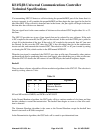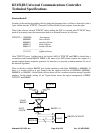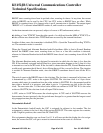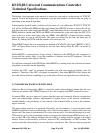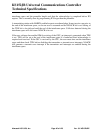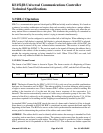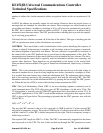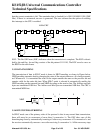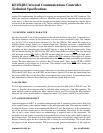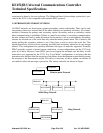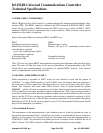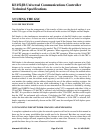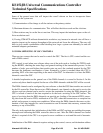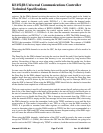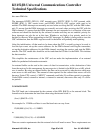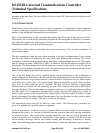
KS152JB Universal Communications Controller
Technical Specifications
Kawasaki LSI USA, Inc. Page 52 of 120 Ver. 0.9 KS152JB2
required for implementing bit stuffing and striping are incorporated into the GSC hardware. This
makes the operation transparent to the user. About the only time this operation becomes apparent
to the user, is if the actual data on the transmission medium is being monitored by a device that is
not aware of the automatic insertion of 0s. The bit stuffing/stripping guarantees that there will be
at least one transition every 6 bit times while the line is active.
3.3.5 SENDING ABORT CHARACTER
An abort character is one of the exceptions to the rule that disallows more than 5 consecutive 1s.
The abort character consists of any occurrence of seven or more consecutive ones. The simplest
way for the C152 to send an abort character is to clear the TEN bit. This causes the output to be
disabled which, in turn, forces it to a constant high state. The delay necessary to insure that the
link is high for seven bit times is a task that needs to be handled by user software. Other methods
of sending an abort character are using the IFS register or using the Raw Transmit mode. Using
IFS still entails clearing the TEN bit, but TEN can be immediately re-enabled. The next message
will not begin until the
IFS expires. The IFS begins timing out as soon as DEN goes high which
identifies the end of transmission. This also requires that IFS contain a value equal to or greater
than 8. This method may have the undesirable effect that
DEN goes high and disables the external
drivers. The other alternative is to switch to Raw Transmit mode. Then, writing OFFH to TFIFO
would generate a high output for 8 bit times. This method would leave
DEN active during the
transmission of the abort character.1
When the receiver detects seven or more consecutive 1s and data has been loaded into the receive
FIFO, the RCABT flag is set in RSTAT and the frame is ignored. If no data has been loaded into
the receive FIFO, there are no abort flags set and that frame is just ignored. A retransmitted frame
may immediately follow an abort character, provided the proper flags are used.
3.3.6 LINE IDLE
If 15 or more consecutive 1s are detected by the receiver the Line Idle (LNI) in TSTAT is set. The
seven 1s from the abort character may be included when sensing for a line idle condition. The
same methods used for sending the Abort character can be used for creating the Idle condition.
However, the values would need to be changed to reflect 15 bit times, instead of seven bit times.
3.3.7 ACKNOWLEDGEMENT
Acknowledgment in SDLC is an implied acknowledge and is contained in the control field. Part
of the control frame is the sequence number of the next expected frame. This sequence number of
is called the Receive Count. In transmitting the Receive Count, the receiver is in fact acknowledg-
ing all the previous frames prior to the count that was transmitted. This allows for the transmis-
sion of up to seven frames before an acknowledge is required back to the transmitter. The
limitation of seven frames is necessary because the Receive Count in the control field is limited to
three binary digits. This means that if an eighth transmission occurred this would cause the next
Receive Count to repeat the first count that still is waiting for an acknowledge. This would defeat
the purpose of the acknowledgment. The processing and general maintenance of the sequence



